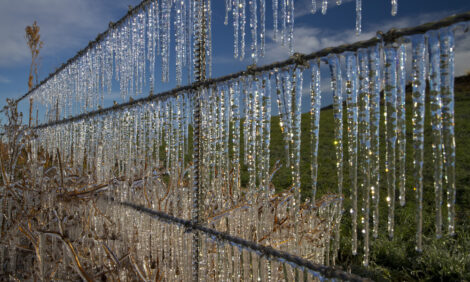



Beef Cattle Management Update
By A. DiCostanzo, Extension Animal Scientist, Beef Cattle Nutrition and Management, University of Minnesota Beef Team. Summer and fall cow-calf management permits producers to get ready for the winter and the next production cycle.Preparation is important to ensure that winter feeding costs are kept as low as possible without affecting calf weight or growth. Two major considerations need to be made when thinking of early fall management:
- cow condition in preparation for winter, and
- calf growth in preparation for marketing.
In order to manage cow condition and calf growth, producers need to: 1) determine body condition score (scale of 1 to 9), 2) evaluate pasture condition and quality, and 3) measure or evaluate calf growth in mid- to late August and a month prior to weaning.
Some situations and recommended actions are given below:
- When cow condition averages below a score of five, pasture condition and calf growth are poor, producers may consider early weaning or creep feeding and pasture supplementation. This strategy permits the calf to recuperate some growth and the cow to regain condition in a compromised pasture situation.
- When calf growth appears normal, but pasture and cow condition are poor (below a score of five), producers may choose to early wean and/or supplement the cow herd. This strategy permits cow reconditioning in a compromised pasture situation. When calf growth and pasture condition are adequate, but cow condition is poor and weaning is less than 45 days away, producers may choose to early wean. This strategy permits cow reconditioning on pasture.
- Early weaning is most successful when calves are 4 months old or older. However, early weaning requires facilities, feed and water. When producers can have access to a clean calf pen or yard that can safely contain young calves and has access to clean, cool water and feeding facilities, early weaning is recommended. Additionally, producers are advised that nutrient needs of calves are higher in protein and relatively high in energy to maintain or improve on growth achieved while on the cow. In general, early-weaned calves weighing 300 to 400 lb will require diets containing 74% TDN and 15% CP. As a general reference, corn contains 90% TDN and 9% CP; barley contains 84%TDN and 13% CP; corn silage contains 70% TDN and 8% CP; alfalfa haylage contains 65% TDN and 17% CP; and soybean meal contains 88% TDN and 50% CP.
Unless maintenance of calf gain is necessary such as when pasture and cow condition are poor (situation 1 above), creep feeding is recommended only when calf prices rise over $80/cwt. Creep feeding is also an alternative when calves will continually be owned through part or all of the finishing period. When presented with the option, calves will eat creep feed and continue to suckle regularly (limiting forage intake). Thus, creep feed cost and quality are important factors to consider when creep feeding. In general, when calf prices are $80/cwt, $90 or $100/cwt, the maximum price a producer can pay for creep feed is $95, $108 or $133/ton (dry basis). Nutrient content of creep feed varies with creep feed intake and cow’s milking ability. When creep feed is fed at 1% of the calf’s body weight (dry basis) and milking ability is moderate to low, creep feed must be formulated to contain 72% to 88% TDN and 20% to 23% CP. Thus, corn-soybean meal-based creep feed works well for low milking ability situations, while small grains-sunflower meal-based creep feed works well for moderate milking ability situations.
Pasture supplementation is recommended only when pasture conditions are poor and the cow will be given a chance to recuperate (in conjunction with early weaning). Feeding the cow to achieve calf gains is usually not cost-effective, because calves convert feed to gain more efficiently than cows. When pasture supplementation is an option, producers should sample pasture clippings to determine what type of supplement to formulate. Energy supplements include corn silage, corn, small grains, corn gluten feed, good quality hay and haylage. Protein supplements include soybean meal, sunflower meal, corn gluten feed, poultry litter, alfalfa hay or haylage. Under most conditions, when pasture energy falls below 56% TDN or 9% CP, or pasture supply is not sufficient, supplementation is required. A simple rule of thumb is to supplement corn (or similar energy equivalent) at the rate of .5 lb (dry basis) for each percentage TDN below 56%. Similarly, supplement soybean meal (or similar protein equivalent) at the rate of .5 lb (dry basis) for each percentage CP below 9%. Thus, if a pasture forage test lists 53% TDN and 7% CP, producers may use 1.5 lb corn and 1 lb soybean meal (dry basis) to meet the respective nutrient deficits.
The situations and recommendations listed herein are but a few of the alternatives producers have to manage cows in the early fall. These guidelines were provided with the objective to reduce winter feeding costs and maintain cow productivity. Feed and cattle prices and cow and calf nutrient needs must always be considered when choosing these or other strategies.
July 1997



